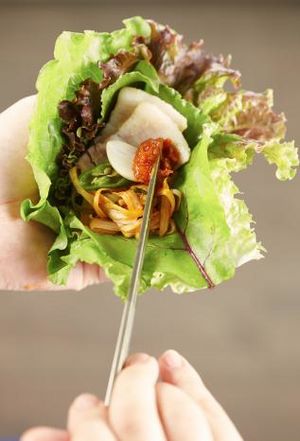Ssam facts for kids
| Ssam | |

lettuce leaf ssam
|
|
Quick facts for kids Korean name |
|
|---|---|
| Hangul |
쌈
|
| Revised Romanization | ssam |
| McCune–Reischauer | ssam |
Ssam (쌈) is a popular Korean dish. The word "ssam" means "wrapped." It's made by wrapping a piece of food, like meat or other fillings, in a fresh leafy vegetable. People often add a special sauce called ssamjang. You can also top your ssam with raw or cooked garlic, onion, green pepper, or a small side dish called banchan, like kimchi. Ssam is usually made small enough to eat in one bite. This helps keep all the yummy fillings inside!
History of Ssam
For a long time in Korea, especially during the Goryeo Kingdom, people were encouraged not to kill or eat animals. This was because of the strong influence of Buddhism. Because of this, many Korean vegetable dishes became very popular. Ssam was one of these important dishes. It was mentioned many times in old Korean writings.
The ancient Korean book of customs, Dongguksesigi, tells a story about ssam. It says that Korean women who worked as servants in the Yuan dynasty ate ssam. They did this to remember the taste of their home country and feel less homesick. The same book also says that ssam became a special dish for holidays by the Joseon era. People especially ate it during a festival called Daeboreum. This ssam was believed to bring good luck and was called bokssam (복쌈), which means "fortune ssam."
Ssam was also written about in many books during the Joseon era. One book, Eou yadam, was a collection of stories by a scholar named Yu Mong-In. He wrote about wrapping a sardine in a leafy vegetable with rice and ssamjang. Another old book, Sasojeol (사소절,士小節), explained good manners. The author, Lee deok-mu, said it was polite to roll a ball of rice first. Then, you would wrap it with a vegetable. He also said to make ssam a bite-sized piece. This was so you wouldn't puff out your cheeks while eating. Jeong Yak-yong, a very famous Joseon thinker, wrote a poem about ssam. He described putting gochujang (a Korean red chili paste) and green onion root on lettuce with rice.
Even a poet from the Yuan dynasty, Yang Yunfu, wrote about ssam from Goryeo. In his poem, Yang noted how people in Goryeo ate rice wrapped in raw vegetables. He even praised the nice smell of Goryeo's lettuce.
Today, ssam is becoming popular outside of Korea. You can find it in restaurants in places like New York City, Tokyo, and Brisbane.
Types of Ssam
Many different vegetables are used for ssam. These include lettuce, cabbage, bean leaves, and pumpkin leaves. They can be used fresh or lightly cooked (blanched). Some people also use seaweed like miyeok (sea mustard) and gim (dried laver). Ssam can also be made with other fillings like beef tongue, roe, pork, clams, or sea cucumbers. These are often wrapped and cooked in eggs.
You can add many side dishes to your ssam. These include kimchi and garlic. For sauces, people use ssamjang, doenjang, red pepper paste, or oil sauce. Sometimes, raw fish (sashimi) and gwamegi (dried herring or pacific saury) are also eaten with wraps.
Ssam by Ingredients
- Bossam: This type of ssam uses steamed pork, often from the shoulder. It's a very popular dish all over Korea.
- Ssambap: This dish always includes rice inside the wrap.
Ssam by Wrap Type
Here are some specific kinds of ssam, named after what they are wrapped in:
- Baechu ssam (배추쌈): Wrapped with a napa cabbage leaf.
- Chwi ssam (취쌈): Wrapped with chwinamul (a type of leafy vegetable).
- Eossam (어쌈): Wrapped with a thin piece of fish.
- Gimssam (김쌈): Wrapped with gim, which is dried seaweed.
- Gotgam ssam (곶감쌈): Wrapped with dried persimmon.
- Hobakip ssam (호박잎쌈): Wrapped with a pumpkin leaf.
- Jeonbok ssam (전복쌈): Wrapped with thin slices of dried abalone that have been soaked.
- Kimchi ssam (김치쌈): Wrapped with kimchi.
- Kkaenip ssam (깻잎쌈): Wrapped with a perilla leaf.
- Milssam (밀쌈): Wrapped with a thin pancake made from wheat flour.
- Muneo ssam (문어쌈): Wrapped with sliced octopus.
- Po'ssam (포쌈): Wrapped with raw beef that has been seasoned.
- Sangchu ssam (상추쌈): Wrapped with lettuce.
Gallery
See also
 In Spanish: Ssam para niños
In Spanish: Ssam para niños







